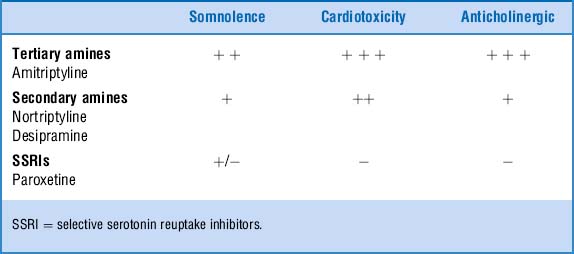CHAPTER 37 ADJUVANT ANALGESICS
1. What are adjuvant analgesics?
Adjuvant analgesics (Table 37-1) are drugs that have primary indications other than pain but are analgesic in some painful conditions. This definition distinguishes a very diverse group of drugs from the traditional analgesics, which comprise the nonopioid analgesics (acetaminophen and the nonsteroidal antiinflammatory drugs) and the opioid analgesics.
TABLE 37-1. Adjuvant Analgesics: Major Classes
| Multipurpose Analgesics | Analgesic Agents for Neuropathic Pain Syndromes | Analgesic Agents for Musculoskeletal Pain Syndromes |
|---|---|---|
| Antidepressants | Antidepressants | Muscle relaxants |
| Alpha-2 adrenergic agonists | Anticonvulsants | Benzodiazepines |
| Corticosteroids | GABA agonists | Analgesic agents for bone pain |
| Topical anesthetics | Oral local anesthetics Topical anesthetics Sympatholytics NMDA receptor blockers Calcitonin | Corticosteroids Osteoclast inhibitors Radiopharmaceuticals |
GABA = gamma-aminobutyric acid, NMDA = N-methyl-D-aspartic acid.
2. For whom and in which situations are adjuvant analgesics appropriate?
 To manage pain that is refractory to the traditional analgesics
To manage pain that is refractory to the traditional analgesics
 To allow reduction in dose of the traditional analgesic for the purpose of lessening side effects
To allow reduction in dose of the traditional analgesic for the purpose of lessening side effects
3. What factors should be considered prior to prescribing an adjuvant analgesic?
 Unapproved indications widely accepted in medical practice
Unapproved indications widely accepted in medical practice
 Common side effects and uncommon, but potentially serious, adverse effects
Common side effects and uncommon, but potentially serious, adverse effects
 Important pharmacokinetic features, including half-life, usual time-action relationships, extent of interindividual variability, and factors that may alter disposition (e.g., age or interactions with other drugs)
Important pharmacokinetic features, including half-life, usual time-action relationships, extent of interindividual variability, and factors that may alter disposition (e.g., age or interactions with other drugs)
9. What is the relative analgesic efficacy of the various antidepressant classes?
There have been few studies directly comparing the analgesic efficacy of the various antidepressant drugs. From the very limited data available, an analgesic response is most likely to be produced by the tertiary tricyclic drugs; amitriptyline is preferred because of the extensive data available for this drug. The secondary amine tricyclic drugs, such as desipramine, are probably less analgesic than the tertiary amine drugs, but are more likely to be effective than the SSRIs. But SSRIs have fewer side effects than either secondary or tertiary amines (Table 37-2). Based on this information, the clinician should attempt to select the drug most likely to provide benefit and be tolerated by the patient.
13. What are the adverse effects of the antidepressants?
The secondary amine TCAs are less toxic than the tertiary amine compounds, and the SNRIs and SSRIs are less toxic than either tricyclic subclass (see Table 37-2). At doses commonly used for pain control, the tricyclic compounds have few serious adverse effects. Cardiovascular toxicity, including hypotension and cardiac arrhythmia, is the most serious concern. Significant heart disease, including conduction disturbances, arrhythmias, or heart failure, is a relative contraindication to treatment. Secondary amine compounds, SNRIs, and SSRIs have a lower incidence of cardiotoxicity and are preferred if cardiac disease is present.








